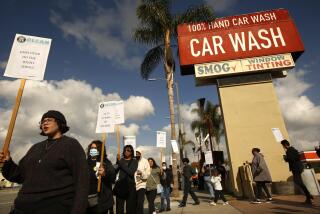FDIC limits make sense -- in principle
Faced with a run on the Northern Rock bank last fall, the British government threw out convention -- and deposit insurance limits -- and declared that all depositors in the bank would be fully protected.
In Japan, deepening worries about the financial system in 1997 spurred the government to issue the same kind of blanket deposit guarantee for all bank customers. That unlimited insurance coverage remained in place until 2002.
But in the U.S., the uninsured depositors of IndyMac Bank found out too late that, well, rules are rules: If their savings exceeded the Federal Deposit Insurance Corp.’s limits, they were out of luck.
There’s a lot of second-guessing about how the FDIC handled Pasadena-based IndyMac’s failure two weeks ago -- and specifically, about the effect on confidence in the banking system after the agency refused to cover the $1 billion of deposits that were above its insurance limits.
Anyone who figured the FDIC was kidding about those limits can’t be thinking that way anymore. IndyMac’s uninsured depositors got 50% of their balances back; any additional payout will depend on what the agency can collect in disposing of the bank’s assets.
Now, some banking industry experts worry that the law of unintended consequences is kicking in. Sticking by the rules, the FDIC could make things harder on itself and the battered financial system.
One worry dogging Wall Street is that many smaller banks could be facing crippling deposit outflows as people reshuffle savings to stay within the insurance parameters.
And in the Internet Age, any bank rumored to be in trouble risks a high-speed run by big depositors who have no desire to play Russian roulette with their money.
In theory, that’s what deposit insurance limits are supposed to do -- force individuals to be disciplined about where they put their cash, which should mean that well-run banks get money and poorly run banks don’t.
But it’s absurd to think that most depositors have the ability to research a bank’s health, says Bert Ely, a veteran industry consultant in Alexandria, Va.
“Even the experts have trouble identifying how much trouble a bank is in,” he said. “If the regulators can’t spot a problem, how the hell do you expect depositors to?”
What’s more, he said, once a bank run by fearful depositors begins, “all it does is make the FDIC’s losses worse than they otherwise would be.” Why? Because the run drains away the deposits that would have made the bank appealing to a potential acquirer.
Ely contends that it makes more sense all around for the government to protect all bank deposits, without limits.
To be sure, IndyMac wasn’t the first bank failure to result in potential losses for uninsured depositors under the FDIC’s statutes. Just since September the agency has taken control of seven other banks, all of which had some uninsured accounts.
But most of the other failures were small institutions. IndyMac, with $32 billion in assets, was the second-biggest bank collapse in U.S. history.
For many Americans, IndyMac may have cemented the belief that the banking system is headed for much harder times as the effects of the housing bust spread. And that risks more depositor panics as rumors fly about which bank might go down next.
When the FDIC can simply merge a troubled bank with a healthier one -- the agency’s preference -- uninsured depositors usually have no worries. That’s what happened Friday when the FDIC closed two bank units of $3.6-billion-asset First National Bank Holding Co. in Arizona and merged them into Mutual of Omaha Bank.
If, however, more big banks skid toward insolvency, and regulators can’t find enough willing acquirers among healthy banks, the government will be forced to take a page from Japan’s crisis playbook in the late 1990s, some experts say. “They’re going to have to think about broadening the deposit guarantee,” said Ethan Harris, chief U.S. economist at brokerage Lehman Bros.
Under current law, however, the FDIC’s hands are tied in dealing with uninsured depositors.
Before 1992, the agency had broad latitude in handling failures. If the FDIC believed that enforcing the rules on uninsured deposits at a failed bank could trigger a systemwide crisis, it could decide to make those depositors whole.
That was the case with the failure of the $22-billion-asset Bank of New England in 1991.
But that didn’t sit well with some in Congress, especially given the ongoing losses to the government from the savings and loan debacle of the 1980s. The “too big to fail” exception was patently unfair, some said.
So later in 1991, Congress passed a law that decreed the FDIC had to resolve every bank failure in the least costly manner to the agency’s insurance fund -- which, for the most part, meant holding to insurance limits, regardless of the broader implications for the banking system.
To cover uninsured depositors now, the FDIC would have to get approval not only from its own board but from the Federal Reserve and the Treasury secretary.
In the big picture, forcing people to be cognizant of deposit insurance limits makes sense in principle. The question is whether the government can hold to principle if people’s uninsured losses at banks begin to add up to serious money, and further erode confidence in the struggling financial system.
--






